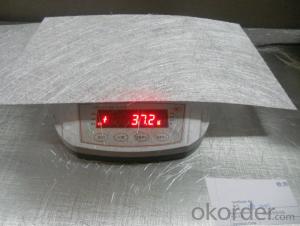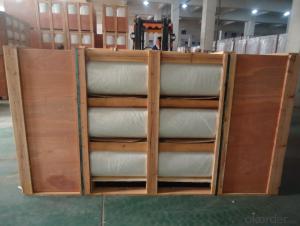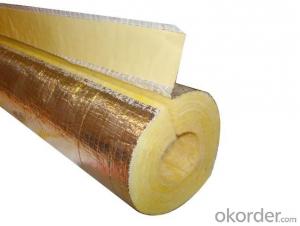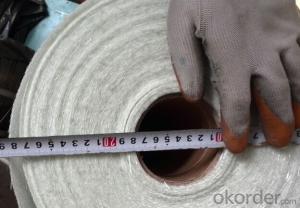E-glass Chopped Strand Mat 2500mm
- Loading Port:
- Shanghai
- Payment Terms:
- TT or LC
- Min Order Qty:
- 1 BOX kg
- Supply Capability:
- 1000MT kg/month
OKorder Service Pledge
OKorder Financial Service
You Might Also Like
1.Breif Introduction
Our chopped strand mat is with width 2500mm, packing in wooden box (pallet)with width 2550mm. In each 40HQ can be loaded 16-18 boxes(pallets), qualitu is around 2000kgs in each container.
2.Main Features
Our chopped strand mat factory specializes in manufacturing E-glass Chopped strand Mat (chopped strand mat manufacturer). The products range from chopped strand mat 300g/m2, chopped strand mat 450g/m2 to chopped strand mat 600g/m2 and 900g, the width from 102cm,104cm,125cm to 320cm.
Standard Specifications for Chopped strand mat
1. High quality
2. ISO9001, 2008 quality controled
3. 320cm width, 100g,300g,450gto 900g
3.Specifications
Product code | Glass type | Unite weight (g/m2) | Width(mm) | Roll weight (kg) | Moisture (%) | Binder content (%) |
100 | E Glass | 100+/-20 | 200-3200 | 30-70 | <0.2-0.3 | 3-4 |
150 | E Glass | 150+/-20 | 200-3200 | 30-70 | <0.2-0.3 | 3-4
|
200 | E Glass | 200+/-20 | 200-3200 | 30-70 | <0.2-0.3 |
3-4
|
300 | E Glass | 300+/-20 | 200-3200 | 30-70 | <0.2-0.3 | 3-4
|
| 450 | E Glass | 450+/-20 | 200-3200 | 30-70 | <0.2-0.3 | 3-4
|
600 | E Glass | 600+/-20 | 200-3200 | 30-70 | <0.2-0.3 | 3-4
|
900 | E Glass | 900+/-20 | 200-3200 | 30-70 | <0.2-0.3 | 3-4
|
Package for Big Width Mat:
1, Each roll will be wound on 4 inches paper core, strong enough for the loading and transportation;
2, Each roll of mat will be wrapped by plastic film;
3, 9 Rolls wil be packed in one wooden frame box;
4, Both side closed by polywood;
5, Steel strip is used for fasten the wooden box.
4. FAQ:
1. Why Choose us?
CNBM is a stated own company, provide the guarantee for the best quality, best service and safety business.
2. How will we guarantee the quality?
a, ISO 9001-2008 quality control system;
b, Strict and regular quality control in production;
c, Inspeciation when loading into container before shippment;
d, Sample stock for one year for quality tracing and record.
3. What is your MOQ?
1000kgs;
4. Can you provide sample?
Yes, we can offer free sample for you.
5. Payment terms?
Accept L/C, T/T etc.
6. Do you offer OEM service?
Yes, we can print customers’ logo on the packaging;
7. What is the Production Lead Time?
1 *40HQ each day, depend on the size of the mat.
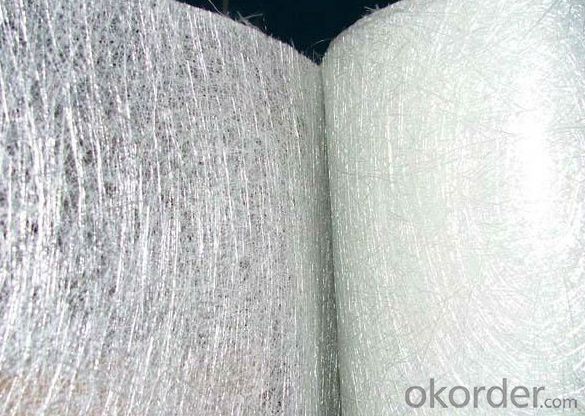
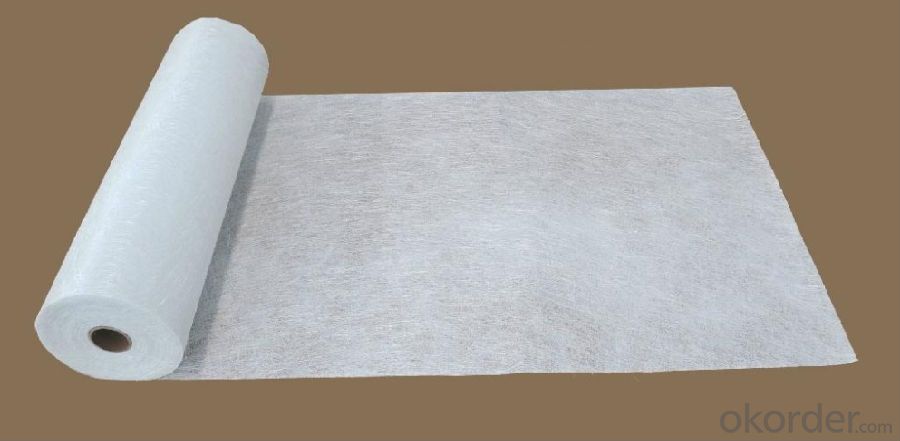
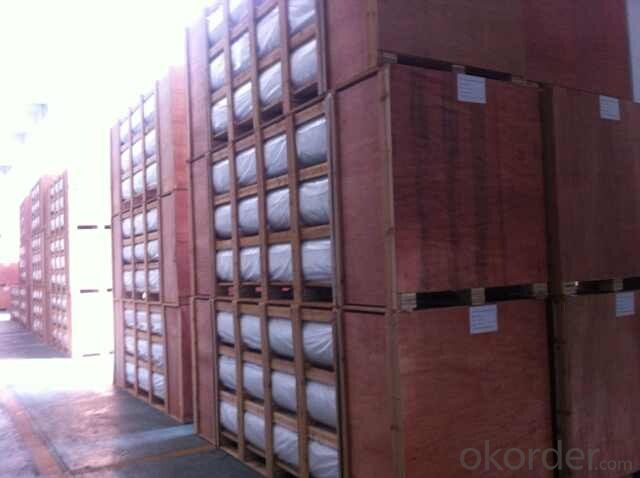
- Q:Can fiberglass mat tissue be used for insulation in cleanrooms?
- Yes, fiberglass mat tissue can be used for insulation in cleanrooms. It is a commonly used material due to its excellent thermal insulation properties, low cost, and high resistance to chemicals and moisture. Additionally, fiberglass mat tissue has low particulate emission, making it suitable for cleanroom environments where maintaining a controlled and sterile atmosphere is crucial.
- Q:Can fiberglass mat tissue be used for automotive applications?
- Yes, fiberglass mat tissue can be used for automotive applications. It is commonly used in the automotive industry for reinforcement and strength in parts such as body panels, hoods, and interior components. It provides excellent thermal and acoustic insulation properties as well.
- Q:Can fiberglass mat tissue be used for bridge deck rehabilitation?
- Yes, fiberglass mat tissue can be used for bridge deck rehabilitation. Fiberglass mat tissue is a versatile material that is known for its high strength and durability. It is commonly used in construction projects, including bridge deck rehabilitation, due to its ability to reinforce and strengthen existing structures. Bridge deck rehabilitation involves repairing and restoring the deck of a bridge that has deteriorated over time. This process typically involves removing the existing damaged concrete, applying a new layer of concrete, and reinforcing it with materials such as fiberglass mat tissue. Fiberglass mat tissue is often used as a reinforcement material in bridge deck rehabilitation due to its excellent mechanical properties. It has high tensile strength, which helps to increase the load-bearing capacity of the bridge deck. Additionally, it is resistant to corrosion, which is particularly important in bridge decks that are exposed to harsh weather conditions and chemicals. Furthermore, fiberglass mat tissue is easy to install and can be applied to bridge decks of various shapes and sizes. It can be embedded into the new concrete layer during construction or applied as an overlay on the existing deck. This flexibility makes it an ideal choice for bridge deck rehabilitation projects. In summary, fiberglass mat tissue can indeed be used for bridge deck rehabilitation. Its high strength, durability, and resistance to corrosion make it a suitable reinforcement material for repairing and strengthening bridge decks. Its ease of installation and versatility further contribute to its suitability for this application.
- Q:How does the width and length of fiberglass mat tissue affect its application?
- The width and length of fiberglass mat tissue can greatly affect its application in various ways. Firstly, the width of the mat tissue determines the coverage area and ease of installation. A wider mat tissue can cover a larger surface area, reducing the number of individual sheets required for a project. This can save time and effort during installation, especially for large-scale applications. Additionally, the width of the mat tissue can affect the overall strength and durability of the finished product. A wider mat tissue provides more reinforcement, making it suitable for applications that require greater strength and stability, such as in the construction of structural components or high-stress areas. On the other hand, the length of the mat tissue impacts the convenience and flexibility during application. Longer rolls of mat tissue allow for continuous installation without the need for frequent seams or joints. This is particularly advantageous when working on large projects, as it minimizes potential weak points and enhances the overall integrity of the fiberglass application. Moreover, the length of the mat tissue also affects the ease of handling and transportation. Longer rolls can be more challenging to maneuver and transport, especially in confined spaces or through narrow doorways. Therefore, the length should be considered based on the accessibility and logistics of the specific application site. In summary, the width and length of fiberglass mat tissue play crucial roles in its application. The width determines the coverage area, strength, and durability, while the length influences the convenience, flexibility, and handling during installation. Considering these factors allows for a more efficient and successful application of fiberglass mat tissue in various industries and projects.
- Q:How does fiberglass mat tissue perform in terms of thermal expansion?
- Fiberglass mat tissue has a relatively low thermal expansion coefficient, meaning it expands minimally when exposed to heat. This characteristic makes it an excellent material for applications where thermal stability is crucial. The tightly woven structure of fiberglass mat tissue helps to limit the expansion and contraction of the material, even under high temperatures. Consequently, it exhibits excellent dimensional stability and resistance to thermal stresses. This property allows fiberglass mat tissue to maintain its structural integrity when exposed to extreme temperature variations, making it highly suitable for use in industries such as aerospace, automotive, and construction, where thermal expansion and contraction can pose significant challenges.
- Q:How is fiberglass mat tissue used in the production of agricultural equipment?
- Fiberglass mat tissue, a type of thin fiberglass material, plays a crucial role in the production of agricultural equipment. It is primarily used as a reinforcement material in the manufacturing process of agricultural equipment, such as tractors, harvesters, and sprayers. One of the main applications of fiberglass mat tissue in agricultural equipment production is in the construction of structural components. The tissue is often used to reinforce the body panels and chassis, providing strength and durability to the equipment. This reinforcement helps to enhance the overall structural integrity and load-bearing capacity of the agricultural machinery, making it more reliable and capable of withstanding the demanding conditions of agricultural operations. Moreover, fiberglass mat tissue is also used in the production of agricultural equipment for its corrosion resistance properties. Agricultural machinery is often exposed to harsh environments, including chemicals, fertilizers, and the elements. By incorporating fiberglass mat tissue into the manufacturing process, the equipment becomes more resistant to corrosion, extending its lifespan and reducing maintenance costs. Additionally, fiberglass mat tissue is utilized in the production of agricultural equipment to improve its insulation and soundproofing capabilities. By incorporating layers of fiberglass mat tissue between the panels and components, the equipment becomes better insulated against temperature fluctuations, reducing energy loss and improving efficiency. Moreover, the tissue helps to dampen noise and vibration, creating a quieter and more comfortable working environment for operators. In summary, fiberglass mat tissue is a critical component in the production of agricultural equipment. Its reinforcement, corrosion resistance, insulation, and soundproofing properties contribute to the overall performance, durability, and efficiency of agricultural machinery, making it an indispensable material in this industry.
- Q:Can fiberglass mat tissue be used for repairing fiberglass truck beds?
- Yes, fiberglass mat tissue can be used for repairing fiberglass truck beds. It is commonly used in such repairs due to its strength, durability, and ability to bond well with the existing fiberglass surface.
- Q:Can fiberglass mat tissue be used for reinforcing wind turbine blades?
- Yes, fiberglass mat tissue can be used for reinforcing wind turbine blades. Fiberglass mat tissue is a lightweight and flexible material made from thin glass fibers bonded together with a resin. It is commonly used in various applications where strength and durability are required, including the construction of wind turbine blades. Wind turbine blades need to be strong yet lightweight to efficiently harness the power of the wind. They are exposed to various forces such as wind loads, vibrations, and extreme weather conditions. Fiberglass mat tissue is an ideal choice for reinforcing these blades due to its excellent mechanical properties. It provides high tensile strength and stiffness, which helps the blades withstand the stress and strain they experience during operation. Additionally, fiberglass mat tissue has good resistance to corrosion and fatigue, which are important factors for the long-term performance of wind turbine blades. It also offers good dimensional stability, ensuring that the shape and integrity of the blades are maintained over time. Furthermore, fiberglass mat tissue can be easily molded and shaped, allowing for complex and aerodynamic blade designs. It can be layered and combined with other materials, such as epoxy resin, to create a composite structure that maximizes the strength and performance of the wind turbine blades. In conclusion, fiberglass mat tissue is a suitable and commonly used material for reinforcing wind turbine blades. Its lightweight, high strength, corrosion resistance, and moldability make it an excellent choice for ensuring the structural integrity and efficiency of wind turbines.
- Q:Is fiberglass mat tissue suitable for railway infrastructure?
- Railway infrastructure can benefit from the use of fiberglass mat tissue. This material is strong and durable, offering excellent resistance to corrosion, weathering, and chemical degradation. It is commonly used in the construction industry to reinforce structures like bridges, tunnels, and platforms. When it comes to railway infrastructure, fiberglass mat tissue provides several advantages. Firstly, it boasts high tensile strength, enabling it to withstand the heavy loads and vibrations caused by train traffic. This prevents cracking and structural damage, ensuring the system's longevity and safety. Furthermore, fiberglass mat tissue is non-conductive, a critical characteristic for railway infrastructure. It reduces the risk of electrical shocks and short circuits, which are common concerns in rail networks. This makes it a reliable choice for railway projects, particularly in areas with electrical lines. Moreover, fiberglass mat tissue is lightweight and easy to handle, making it convenient for installation in railway projects. It also offers resistance to fire, making it a safe option for fire protection in railway infrastructure. Overall, fiberglass mat tissue is a suitable material for railway infrastructure due to its strength, durability, non-conductive nature, and fire resistance. Its use in railway construction contributes to the reliability, longevity, and safety of the railway system.
- Q:Can fiberglass mat tissue be used for lightweight construction?
- Yes, fiberglass mat tissue can be used for lightweight construction. Fiberglass mat tissue is a thin and lightweight material made up of randomly oriented glass fibers bonded together with a binder. It is commonly used as a reinforcement material in composite laminates and is known for its excellent strength-to-weight ratio. In lightweight construction, where weight reduction is a key consideration, fiberglass mat tissue can be an ideal choice. Its low weight adds minimal additional load to the structure while still providing sufficient strength and durability. The random orientation of the fibers in the mat tissue ensures that the load is evenly distributed, further enhancing its strength properties. Additionally, fiberglass mat tissue is easy to handle and can be easily molded into various shapes and forms. This flexibility makes it suitable for applications in lightweight construction, such as in the production of lightweight panels, wall partitions, and roof structures. The material can also be used in combination with other lightweight materials, such as foam cores or honeycomb structures, to further enhance its lightweight properties. Overall, fiberglass mat tissue is a versatile material that can be effectively used for lightweight construction. Its lightweight nature, combined with its strength and durability, make it a suitable choice for various applications where weight reduction is a priority.
1. Manufacturer Overview |
|
|---|---|
| Location | |
| Year Established | |
| Annual Output Value | |
| Main Markets | |
| Company Certifications | |
2. Manufacturer Certificates |
|
|---|---|
| a) Certification Name | |
| Range | |
| Reference | |
| Validity Period | |
3. Manufacturer Capability |
|
|---|---|
| a)Trade Capacity | |
| Nearest Port | |
| Export Percentage | |
| No.of Employees in Trade Department | |
| Language Spoken: | |
| b)Factory Information | |
| Factory Size: | |
| No. of Production Lines | |
| Contract Manufacturing | |
| Product Price Range | |
Send your message to us
E-glass Chopped Strand Mat 2500mm
- Loading Port:
- Shanghai
- Payment Terms:
- TT or LC
- Min Order Qty:
- 1 BOX kg
- Supply Capability:
- 1000MT kg/month
OKorder Service Pledge
OKorder Financial Service
Similar products
New products
Hot products
Hot Searches
Related keywords
